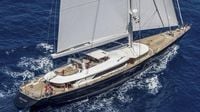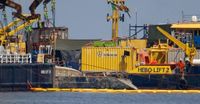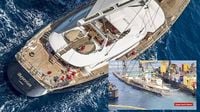After lying submerged for nearly ten months, the British luxury superyacht Bayesian has been triumphantly raised from the depths off the coast of Sicily, marking a significant milestone in a complex and costly salvage operation. The 56-meter (184-foot) vessel, which capsized and sank during a violent storm on August 19, 2024, claimed seven lives, including the renowned tech entrepreneur Mike Lynch and his 18-year-old daughter, Hannah.
The salvage operation, led by British firm TMC Marine and costing approximately $30 million, has been a painstaking process involving cutting-edge technology, powerful cranes, and a team of about 70 specialists. Over the past three days leading up to June 20, 2025, the hull was carefully lifted from its resting place 50 meters (165 feet) below the surface of the Tyrrhenian Sea near Porticello, Sicily.
Using a combination of eight steel lifting straps, slings, and harnesses specially designed for this delicate task, the salvage team, supported by the massive 5,695-gross-tonne floating crane Hebo Lift 10 and its sister vessel Hebo Lift 2, gradually eased the Bayesian into an upright position. This maneuver exposed the starboard side, which had been pressed against the seabed, allowing for further inspection and preparation for the final lift.
Earlier in the week, a specialized remote-controlled diamond-wire cutting tool was employed to detach the yacht’s towering 72-meter (236-foot) mast. The mast, one of the tallest in the world, had been a major obstacle to raising the hull upright. After removal, it was carefully lowered back to the seabed for later recovery.
On the afternoon of June 20, the white top and blue hull of the Bayesian emerged from the water, covered in clay and algae, signaling the operation’s success in its initial phase. The lifting paused temporarily at this point to reinforce the rigging and inspect the vessel’s structural integrity before proceeding further.
The Bayesian, valued at $40 million, sank in under a minute during a sudden storm that brought hurricane-force winds exceeding 70 knots (81 mph). The vessel was anchored off Porticello near Palermo, Sicily, seeking shelter from forecasted thunderstorms. However, a violent gust knocked the yacht over to a 90-degree angle in less than 15 seconds, leaving passengers trapped below deck. Among the victims were Mike Lynch, his daughter Hannah, four of Lynch’s friends—including a prominent lawyer and his wife—and the yacht’s chef. Fifteen others, including Lynch’s wife Angela Bacares, the captain James Cutfield, and most crew members, survived.
The tragedy has been shrouded in mystery and controversy. The yacht’s builder, previously touting the Bayesian as “unsinkable,” faced accusations from the owning company blaming the crew for a chain of fatal errors. A preliminary report by the UK’s Marine Accident Investigation Branch (MAIB) suggested the vessel was vulnerable to high winds when running on its engine, vulnerabilities unknown to both owner and crew, as they were not included in the stability information onboard.
Investigators are particularly interested in examining the yacht’s internal layout, including access doors and the retractable keel position, to determine why the vessel capsized and failed to recover. The speed of the sinking, reportedly within two minutes, has raised questions about whether hatches were left open or if the keel was improperly raised, compromising stability.
The salvage operation also has an environmental dimension. The Bayesian sank with approximately 18,000 liters of fuel still onboard, prompting the deployment of oil booms to protect the surrounding protected marine area from pollution during recovery. Continuous monitoring for any environmental hazards is ongoing.
Following the initial lift, the Bayesian is scheduled to be fully raised out of the water by June 21, weather permitting, and transported roughly 10 miles to the Sicilian port of Termini Imerese. There, it will be placed in a specially constructed steel cradle on the quayside for forensic examination.
Prosecutors in Palermo have opened a criminal investigation into the sinking, charging the captain, engineering officer, and watchman with multiple counts of manslaughter and negligence. Meanwhile, a separate inquiry is underway regarding the death of a Dutch diver, Rob Cornelis Maria Huijben, who tragically died in an underwater explosion during salvage efforts in May 2025. This incident led to a shift from human divers to remote-controlled underwater robots, accelerating progress in the recovery operation.
Investigators also seek to secure possessions onboard, including watertight safes believed to contain encrypted hard drives owned by Lynch. Concerns over the sensitivity of these materials have prompted heightened security measures around the wreck site, including a strict cordon of one nautical mile by air and 650 meters by sea.
Mike Lynch had been celebrating his acquittal on 15 felony charges related to the $11 billion sale of his company Autonomy to Hewlett-Packard when he organized the ill-fated voyage. The cruise was intended as a joyous occasion with family and close friends, making the tragedy all the more poignant.
The recovery of the Bayesian’s hull is expected to provide vital clues to the sequence of events leading to the disaster, potentially shedding light on whether human error, design flaws, or unforeseen natural forces were to blame. The investigation may take several more months, with the salvage operation itself continuing as teams plan to return to the seabed to retrieve the mast and other debris.
Captain Nick Sloane, famed for his role in the 2014 Costa Concordia salvage, described the operation as highly complex, emphasizing the importance of treating the yacht “as a graveyard” given the lives lost. He noted that the initial lift involved stabilizing the vessel just off the seabed and conducting thorough inspections to ensure the rigging points and recovery straps were secure.
As the Bayesian now rests in its cradle at Termini Imerese, the world watches closely, awaiting answers to a tragedy that has gripped the maritime and tech communities alike. The salvage and investigation represent a painstaking quest for truth and closure amid the lingering questions of how a vessel deemed “unsinkable” met such a catastrophic fate.






